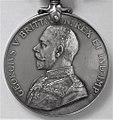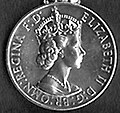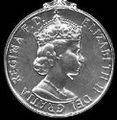Military Medal
| Military Medal | |
|---|---|
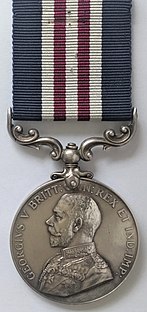 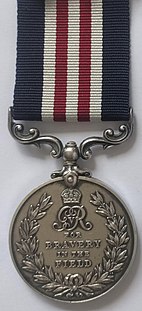 Obverse and reverse of medal | |
| Type | Military decoration |
| Awarded for | Acts of gallantry and devotion to duty under fire |
| Presented by | UK and Commonwealth |
| Eligibility | British and Commonwealth forces |
| Status | Discontinued in 1993 |
| Established | 25 March 1916 (backdated to 1914) |
Ribbon bar Ribbon bar with rosette to indicate second award Second award bar | |
| Order of Wear | |
| Next (higher) | Distinguished Service Medal[1] |
| Next (lower) | Distinguished Flying Medal[1] |
| Related | Military Cross |
The Military Medal (MM) was a
History
The Military Medal was established on 25 March 1916.
When the medal was first introduced, it was unpopular among regular soldiers. MM and DCM recipient
From September 1916 members of the Royal Naval Division, serving on Western Front alongside the Army, were made eligible for military decorations, including the Military Medal, for the war's duration.[4] It could also be awarded to members of the Royal Air Force for gallant service on the ground.[8]
Eligibility for the MM was extended, by a Royal Warrant dated 21 June 1916, to women whether British subjects or foreign, with the first awards gazetted on 1 September 1916. Although nurses of the Queen Alexandra's Imperial Military Nursing Service (QAIMNS) and the Territorial Force Nursing Service (TFNS) and other women serving with the British Army often had the social status of officers, they did not hold an officer's commission and were therefore ineligible for the Military Cross, but could be and were awarded the MM.[9] Louisa Nolan, a civilian during the Easter Rising in Dublin, was awarded the Military Medal for her courage under fire in providing humanitarian aid to the wounded.[10]
Since 1918 recipients of the Military Medal have been entitled to the post-nominal letters "MM".[11][12]
Eligibility was extended to soldiers of the Indian Army in 1944.[13]
The Military Medal was discontinued in 1993, as part of the review of the British honours system, which recommended removing distinctions of rank in respect of awards for bravery. Since then the Military Cross, previously only open to
Description
The medal and ribbon had the following features:[3][4]
- A circular silver medal of 36 mm diameter.
- The obverse bears the effigy of the reigning monarch and an appropriate inscription.
- The reverse has the inscription "FOR BRAVERY IN THE FIELD" in four lines, surrounded by a Royal Cypher and Imperial Crown.
- The suspender is of an ornate scroll type.
- The ribbon is dark blue, 1.25 inches wide with five equal centre stripes of white, red, white, red, and white, each 0.125 inches wide.
- The name and service details of the recipient were impressed on the rim of the medal, although honorary awards to foreign recipients were issued unnamed.
- Silver, laurelled bars were authorised for subsequent awards, with a silver rosette worn on the ribbon bar to indicate the award of each bar.
Obverse variations
The medal was awarded with one of six obverse designs:[4]
-
George V (1st type) in Field Marshal's uniform (1916–1930)
-
George V (2nd type) in crown and robes (1930–1937)
-
George VI (1st type); inscribed 'INDIAE IMP' (1938–1948)
-
George VI (2nd type); omits 'INDIAE IMP' (1949–1952)
-
Elizabeth II (1st type); inscription has 'BR OMN' (1952–1958)
-
Elizabeth II (2nd type); inscription has 'DEI GRATIA' (1958–1993)
Numbers of awards
Between 1916 and 1993 approximately 138,517 medals and 6,167 bars were awarded.[4] The dates below reflect the relevant London Gazette entries:
| Period | Medals | 1st bar | 2nd bar | 3rd bar | Honorary awards | |
|---|---|---|---|---|---|---|
| World War I | 1916–20 | 115,589 | 5,796 | 180 | 1 | 7,930[15] |
| Inter–War | 1920–39 | 311 | 4 | – | – | – |
| World War II | 1939–46 | 15,225 | 177 | 1 | – | 660 |
| Post–War | 1947–93 | 1,044[16] | 8 | – | – | – |
| Total | 1916–1993 | 132,169 | 5,985 | 181 | 1 | 8,590 |
The above figures include awards to the
In all, 13,654 Military Medals were awarded to those serving with Canadian forces, including 848 first bars and 38 second bars.[17]
Australian Army members received 11,038 and 14 were to awarded Air Force personnel; 478 first bars were awarded, 15 second bars and one third bar.[14]
Over 2,500 were awarded to New Zealanders, the last being for the Vietnam War.[18]
The honorary MM awards were made to servicemen and women from eleven allied countries in the First World War, and nine in the Second World War.[4]
During the First World War, 127 Military Medals were awarded to women, plus about a dozen honorary awards to foreign women.[19]
There was one instance of a third bar being awarded,
The only recipient to receive two bars during the Second World War was Sergeant Fred Kite, Royal Tank Regiment.[20]
Selected recipients of the Military Medal

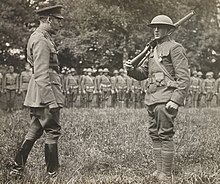
Nearly 140,000 people have been awarded the Military Medal. Among the more notable recipients are:
World War I
- Billy Bennett, British comedian.
- Joe Cassidy, Scottish footballer.
- Phoebe Chapple, Australian medical practitioner, first female doctor awarded the Military Medal
- Mairi Chisholm, British volunteer ambulance driver.
- Douglas Clark, British rugby league footballer and wrestler.
- Jack Clough, British footballer.
- Jack Cock, British footballer.
- William Coltman, who was also awarded the Victoria Cross, and was the most highly decorated NCO of the First World War.
- Ernest Albert Corey, the only person to be awarded the MM four times.[14]
- Lady Dorothie Feilding, first woman to be awarded the MM.
- Elsie Knocker, British volunteer nurse and ambulance driver.
- Norman Washington Manley, former First Minister of Jamaica, sergeant in the British Army during the First World War.
- James McCudden, the most highly decorated British pilot of the First World War.
- Richard McFadden, professional footballer with Clapton Orient, who was killed on the Somme on 23 October 1916.
- Labor Partypremier since 1932.
- Francis Pegahmagabow, Canadian Expeditionary Force, Canada's most decorated indigenous soldier of the First World War, who was awarded 2 additional bars to his Military Medal.
- Frank Richards, who wrote about his wartime experiences, and who received both the DCM and the MM.
- Caleb James Shang, DCM & Bar, MM was the most highly decorated Chinese Australian soldier who served in the First World War
- Charles Rutherford, awarded the Military Cross, Military Medal and Victoria Cross.
- Violetta Thurstan, nurse in World War One, evacuated wounded soldiers while under fire.
- Karl Vernon, Olympic medallist oarsman and coach.
- Arthur Wesley Wheen, translator of All Quiet on the Western Front.
- Arch Whitehouse, World War I RAF Officer.
- Major-General F. F. Worthington was awarded the Military Medal for actions near Vimy Ridge.
- Langford Wellman Colley-Priest, Australian stretcher-bearer
- George Robb (MM) Service No 22822 Born in Aberdeen, later of Willesden Middlesex, Served in 18th & 20th Kings Liverpool Regiment, Awarded the Military Medal for bravery and escaping Munster III PoW camp in Westphalia Germany. Wounded & Survived the great war.
World War II
- Geoffrey Bingham, Australian theologian and author.
- Walter Bingham, Jewish refugee from Nazi Germany who served in Normandy and subsequently in Counter Intelligence.
- Barney F. Hajiro, Japanese American soldier and Medal of Honor recipient, awarded for his actions in France in 1944.
- Elspeth Candlish Henderson, a WAAF NCO during the Battle of Britain
- William Hutt, Canadian actor.
- Fred 'Buck' Kite, the only British soldier to be awarded the MM and two Bars in the Second World War.
- Bob Lilley, founding member of the British Special Air Service, one of the "Tobruk Four".
- Devil's Brigade, Canada's most decorated aboriginal soldier of the Second World War, who also received the US Silver Star.
- Bob Quinn, leading Australian rules footballer.
- Wilfred Sénéchal, New Brunswick, Canada lawyer, politician.
- Karam Singh, Indian soldier later awarded the Param Vir Chakra, India's highest military decoration.
- Randall Swingler, British poet.
- Rangers and Scotlandfootballer.
- Berry Gazi, first Black South African to be awarded the Military Medal.
- Leslie "Bull" Allen, Australian stretcher bearer
Post 1945
- Ian Bailey, The Parachute Regiment, for actions in the Falklands War
- Corporal Stephen Newland, H.M. Royal Marines - Awarded the Military Medal for his gallantry during operations in the Falklands War
- Corporal Michael Eccles, H.M. Royal Marines - Awarded the Military Medal for his gallantry during operations in the Falklands War
- Corporal Chrystie Ward, H.M. Royal Marines - Awarded the Military Medal for his gallantry during operations in the Falklands War
- Robert Gaspare Consiglio, Special Air Service, killed in action during Bravo Two Zero patrol, Iraq 1991.[21]
- Billy Hanna, Royal Ulster Rifles, for gallantry in the Korean War.
- Steven John Lane, Special Air Service, died during Bravo Two Zero patrol, Iraq 1991.[21]
- John McAleese, British Special Air Service, for service in Ulster in 1987.
- Andy McNab (pseudonym), Special Air Service, for service in Ulster in 1979.
- Chris Ryan (pseudonym), Special Air Service, Bravo Two Zero patrol, Iraq 1991.
- Al Slater, Special Air Service, for service in Ulster.
Popular culture
Jack Ford, a leading character in the BBC TV series
In the BBC series Peaky Blinders, the principal protagonist/antihero Thomas Michael Shelby is a recipient of the Distinguished Conduct Medal and the Military Medal for his service in World War I, then post-war he was awarded the OBE by Winston Churchill.[citation needed]
In the
In ANZAC Girls episode 6, "Courage", Sister Ross-King and three other nurses are awarded the Military Medal for bravery under fire.[citation needed]
In the video game
See also
- British and Commonwealth orders and decorations
- Military decoration
References
- ^ a b "JSP 761 Honours and Awards in the Armed Forces" (PDF). p. 12A-1. Archived from the original (PDF) on 2 August 2020. Retrieved 7 November 2014.
- ^ a b "No. 29535". The London Gazette (1st supplement). 4 April 1916. p. 3647.
- ^ a b "The British (Imperial) Military Medal". Vietnam Veterans of Australia Association. Retrieved 4 May 2014.
- ^ ISBN 9780902633742, Chapter 33, The Military Medal
- ISBN 978-1-9996727-1-3.
- ^ Richards, Frank. Old Soldiers Never Die. (Library of Wales) (Kindle Locations 1742-1745). Parthian Books. Kindle Edition.
- ^ Including bars: 25,101 awards of DCM and 121,566 of MM. See pages 82 and 226, British Gallantry Awards, (2nd ed), Abbott & Tamplin.
- ^ Captain H. Taprell Dorling. Ribbons and Medals. p. 49. Published A.H.Baldwin & Sons, London. 1956.
- ^ Abbott & Tamplin, British Gallantry Awards, 2nd edition. Page 224, note 4.
- ^ BBC "The Military Medal for bravery" 23 March 2016
- ^ British Army Order No. 13 of January 1918
- ^ a b Duffy, Michael. "Encyclopaedia: Military Medal". Retrieved 4 May 2014.
- ^ Peter Duckers. British Gallantry Awards 1855 – 2000. pp. 44–46.
- ^ a b c d "Imperial Awards". It's an Honour. Australian Government. Archived from the original on 23 June 2006. Retrieved 4 May 2014.
- ^ Howard Williamson. Awards of the DCM and MM to the Allied armies during the Great War of 1914-20. Orders & Medals Research Society Journal, Vol 59, No 1. March 2020, p 13. Numbers based on names published in the War Office Lists up to August 1925 and includes MMs for Russian intervention 1919-20.
- ^ Abbott & Tamplin, British Gallantry Awards, 2nd edition, page 228 confirms 932 medals and 8 bars for 1947-79. A further 112 MMs awarded 1980-93: 65 for Northern Ireland; 34 for Falklands War, (Supplement to London Gazette 8 October 1982); and 13 for Gulf War, (Supplement to London Gazette, 29 June 1991).
- ^ Veterans Affairs Canada – Military Medal (MM) (Retrieved 1 November 2018)
- ^ New Zealand Defence Force: British Commenwealth Gallantry Awards - The Military Medal (Retrieved 1 November 2018)
- ^ "The King's Own Royal Regiment Museum, Military Medal". Retrieved 1 November 2018.
- ^ See note 34, page 228, British Gallantry Awards, (2nd ed), Abbott & Tamplin.
- ^ a b "No. 54393". The London Gazette. 9 May 1996. p. 6549.
- ^ BBC website: Dad's Army episodes
External links
- "The King's Own Royal Regiment Museum, (Lancaster), Military Medal". www.kingsownmuseum.plus.com.
- "Further information and tools to identify British medals". www.military-medal.co.uk. Archived from the original on 11 August 2008.
- "International Medallists to the Royal British Legion". www.awardmedals.com.
- Search over 5 million campaign medal cards on The UK National Archives' website.

